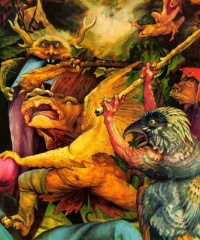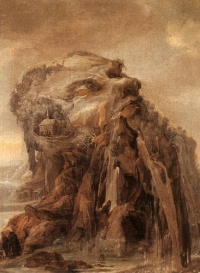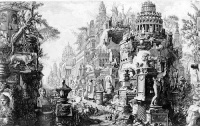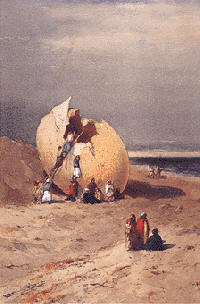Fantastic art
From The Art and Popular Culture Encyclopedia
| Revision as of 20:15, 17 October 2021 Jahsonic (Talk | contribs) ← Previous diff |
Revision as of 20:03, 11 July 2022 Jahsonic (Talk | contribs) Next diff → |
||
| Line 3: | Line 3: | ||
| | style="text-align: left;" | | | style="text-align: left;" | | ||
| "The four floors of the Museum will be devoted to the exhibition, which will include more than 700 objects [...] ranging from such extremes as [[Giovanni di Paolo]] and [[Leonardo da Vinci]] of the fifteenth century to [[Walt Disney]], [[Rube Goldberg]] and [[Thurber]] of the twentieth century, and including such famous names both old and modern as [[Hieronymus Bosch]], [[Duerer]], [[Arcimboldo]], [[Hogarth]], [[William Blake]], [[Cruickshank]], [[Lewis Carrol]], [[Daumier]], [[Delacroix]], [[Edward Lear]], [[Redon]], [[Chagall]], [[de Chirico]], [[Duchamp]], [[Picasso]], [[Arp]], [[Dali]], [[Ernst]], [[Grosz]], [[Magritte]], [[Miro]], [[Klee]], [[Man Ray]], [[Tanguy]], [[Peter Blume]], [[Georgia O'Keeffe]], and [[Alexander Calder]]."--''[[Fantastic Art, Dada, Surrealism]]'' (1936) | "The four floors of the Museum will be devoted to the exhibition, which will include more than 700 objects [...] ranging from such extremes as [[Giovanni di Paolo]] and [[Leonardo da Vinci]] of the fifteenth century to [[Walt Disney]], [[Rube Goldberg]] and [[Thurber]] of the twentieth century, and including such famous names both old and modern as [[Hieronymus Bosch]], [[Duerer]], [[Arcimboldo]], [[Hogarth]], [[William Blake]], [[Cruickshank]], [[Lewis Carrol]], [[Daumier]], [[Delacroix]], [[Edward Lear]], [[Redon]], [[Chagall]], [[de Chirico]], [[Duchamp]], [[Picasso]], [[Arp]], [[Dali]], [[Ernst]], [[Grosz]], [[Magritte]], [[Miro]], [[Klee]], [[Man Ray]], [[Tanguy]], [[Peter Blume]], [[Georgia O'Keeffe]], and [[Alexander Calder]]."--''[[Fantastic Art, Dada, Surrealism]]'' (1936) | ||
| + | <hr> | ||
| + | "They did not indeed relinquish the things in which they had delighted during the epoch in which [[van Eyck]] dominated northern art. After engravers of the fifteenth century, [[Schongauer]] and the master who signs himself [[E. S.]], had begun to represent scenes from everyday life, such themes were now made subjects of pictures. After van Eyck had carefully painted every bud and leaf, and [[Goes]] and [[Memling]] had followed with real landscapes as backgrounds, the study of [[landscape painting]] as an independent branch was now begun. In addition to this, painting mastered a third domain: [[the fantastic]]. As long as the spirit of realism prevailed, artists had painted only what they saw, looking with suspicious eye upon anything beyond this. But when, in consequence of the ecclesiastical reaction, metaphysical tendencies followed the realistic, the fantastic element at once appeared. It was developed to an even greater extent in the North than in Italy, because the fantastic is a more important element in the northern than in the Italian character. The art of engraving, which, with greater facility than the brush, follows the spirit into the world of [[fable]], became of determinative importance. After Schongauer in his ''[[Temptation of St. Antony]]'' had first modestly entered the territory the artists who followed him took possession of the entire legendary domain. "--''[[The History of Painting: From the Fourth to the Early Nineteenth Century]]'' (1893/94) by Richard Muther | ||
| + | |||
| |} | |} | ||
| [[Image:The Temptation of St. Anthony by Grunewald.jpg|thumb|right|200px|''[[The Temptation of St. Anthony (theme in the visual arts)|The Temptation of St. Anthony]]'' ([[16th century]]) by [[Matthias Grünewald]]]][[Image:Joos de Momper.jpg|thumb|right|200px|''[[Winter]]'', one of the ''[[The Four Seasons (Joos de Momper)|The Four Seasons]]'' (early [[17th century]]) by [[Joos de Momper]]]] | [[Image:The Temptation of St. Anthony by Grunewald.jpg|thumb|right|200px|''[[The Temptation of St. Anthony (theme in the visual arts)|The Temptation of St. Anthony]]'' ([[16th century]]) by [[Matthias Grünewald]]]][[Image:Joos de Momper.jpg|thumb|right|200px|''[[Winter]]'', one of the ''[[The Four Seasons (Joos de Momper)|The Four Seasons]]'' (early [[17th century]]) by [[Joos de Momper]]]] | ||
Revision as of 20:03, 11 July 2022
|
"The four floors of the Museum will be devoted to the exhibition, which will include more than 700 objects [...] ranging from such extremes as Giovanni di Paolo and Leonardo da Vinci of the fifteenth century to Walt Disney, Rube Goldberg and Thurber of the twentieth century, and including such famous names both old and modern as Hieronymus Bosch, Duerer, Arcimboldo, Hogarth, William Blake, Cruickshank, Lewis Carrol, Daumier, Delacroix, Edward Lear, Redon, Chagall, de Chirico, Duchamp, Picasso, Arp, Dali, Ernst, Grosz, Magritte, Miro, Klee, Man Ray, Tanguy, Peter Blume, Georgia O'Keeffe, and Alexander Calder."--Fantastic Art, Dada, Surrealism (1936) "They did not indeed relinquish the things in which they had delighted during the epoch in which van Eyck dominated northern art. After engravers of the fifteenth century, Schongauer and the master who signs himself E. S., had begun to represent scenes from everyday life, such themes were now made subjects of pictures. After van Eyck had carefully painted every bud and leaf, and Goes and Memling had followed with real landscapes as backgrounds, the study of landscape painting as an independent branch was now begun. In addition to this, painting mastered a third domain: the fantastic. As long as the spirit of realism prevailed, artists had painted only what they saw, looking with suspicious eye upon anything beyond this. But when, in consequence of the ecclesiastical reaction, metaphysical tendencies followed the realistic, the fantastic element at once appeared. It was developed to an even greater extent in the North than in Italy, because the fantastic is a more important element in the northern than in the Italian character. The art of engraving, which, with greater facility than the brush, follows the spirit into the world of fable, became of determinative importance. After Schongauer in his Temptation of St. Antony had first modestly entered the territory the artists who followed him took possession of the entire legendary domain. "--The History of Painting: From the Fourth to the Early Nineteenth Century (1893/94) by Richard Muther |
|
Related e |
|
Featured: |
Fantastic art is an art genre. The parameters of fantastic art have been tentatively defined in the scholarship on the subject ever since the 19th century. However, the genre had to wait for the inter war period to be mentioned by name at the "Fantastic Art, Dada, Surrealism" exhibition of winter 1936/1937 at the Museum of Modern Art in New York City, which displayed pre-surrealist works such as The Titan's Goblet by Thomas Cole.
Fantasy has been an integral part of art since its beginnings, but has been particularly important in mannerism, magic realist painting, romantic art, symbolism, surrealism and lowbrow. In French, the genre is called le fantastique, in English it is sometimes referred to as visionary art, grotesque art or mannerist art. It has had a deep and circular interaction with fantasy literature.
Fantastic art explores fantasy, "space fantasy" (a sub-genre which incorporates subjects of alien mythology and/or alien religion), imagination, the dream state, the grotesque, visions and the uncanny, as well as so-called "Goth" art. Being an inherent genre of Victorian Symbolism, modern fantastic art often shares its choice of themes such as mythology, occultism and mysticism, or lore and folklore, and generally seeks to depict the [inner life] (nature of soul and spirit).
Fantastic art should not be confused with fantasy art, which is the domain of science-fiction and fantasy illustrators such as Boris Vallejo and others.
Contents |
Historic artists and fine artists
Fantastic art is a loosely defined art genre. However, the first "fantastic" artist is generally believed to be Hieronymus Bosch.
Middle Ages and Renaissance
The first "fantastic" artist is generally said to be Hieronymus Bosch. Other medieval and Renaissance artists who have been labeled fantastic include Matthias Grünewald, Hans Baldung Grien, Brueghel and Giuseppe Arcimboldo.
In Italy, the fashion for grotesque art starts.
17th century
Jacques Callot, but also the Mannerist and baroque grotesque and the auricular style and the Bizzarie di varie figure (1624) by Giovanni Battista Braccelli.
18th century
Giovanni Battista Piranesi, Henry Fuseli, Francisco de Goya.
But also sets of ornamental prints such as Les costumes grotesques et les métiers (c. 1695) by Nicolas de Larmessin II and Mascarade à la Grecque (1771) by Ennemond Alexandre Petitot and the fantastic architecture of Étienne-Louis Boullée, Claude Nicolas Ledoux and Jean-Jacques Lequeu.
19th century
William Blake, Gustave Doré, Gustave Moreau, Arnold Böcklin, Odilon Redon, Max Klinger. Lesser known artists include Charles-Frédéric Soehnée. Artists working in the print medium were Grandville.
20th century
Salvador Dalí, Rudolf Hausner, Johfra, H. R. Giger, Odd Nerdrum, Mati Klarwein,Ernst Fuchs and Paul Rumsey.
Also deserving to be mentioned is Artforms of Nature (1904) by Ernst Haeckel.
United States
In the United States in the 1930s, a group of Wisconsin artists inspired by the Surrealist movement of Europe created their own brand of fantastic art. They included Madison, Wisconsin-based artists Marshall Glasier, Dudley Huppler and John Wilde; Karl Priebe of Milwaukee and Gertrude Abercrombie of Chicago. Their art combined macabre humor, mystery and irony which was in direct and pointed contradiction to the American Regionalism then in vogue.
In postwar Chicago the art movement Chicago Imagism produced many fantastic and grotesque paintings, which were little noted because they did not conform to New York abstract art fashions of the time. Major imagists include Roger Brown, Gladys Nilsson, Jim Nutt, Ed Paschke, and Karl Wirsum.
Historiography
The historiography of fantastic art began when the Surrealists started to inspect their roots and drew up a list of their predecessors, see Proto-Surrealism.
Bibliography
- L'art fantastique (1961) - Marcel Brion
- Au cœur du fantastique (1965) - Roger Caillois
- Dreamers of Decadence: Symbolist Painters of the 1890s (1969) - Philippe Jullian
- Quatre siècles de Surréalisme (1973) by Pierre Belfond
- The Occult in Art (1990) - Owen S. Rachleff
- Les peintres du fantastique (1996) - André Barret
See also
- Alchemy in art and entertainment
- Dream art
- Grotesque art
- Phantasticus
- Surrealism
- Neosurrealism
- Fantastic Art Centre
- Society for the Art of Imagination
_by_Arcimboldo_in_the_Kunsthistorisches_Museum_Wien.jpg)





_.jpg)




